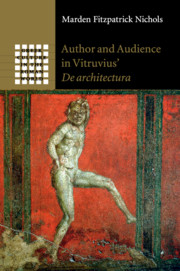Refine search
Actions for selected content:
5894 results in Classical art and architecture
Four - Turmoil and Tension
-
- Book:
- Architecture and Politics in Republican Rome
- Published online:
- 21 September 2017
- Print publication:
- 07 December 2017, pp 75-146
-
- Chapter
- Export citation
Five - Civil War and Aftermath
-
- Book:
- Architecture and Politics in Republican Rome
- Published online:
- 21 September 2017
- Print publication:
- 07 December 2017, pp 147-182
-
- Chapter
- Export citation
Introduction
-
- Book:
- Architecture and Politics in Republican Rome
- Published online:
- 21 September 2017
- Print publication:
- 07 December 2017, pp xi-xii
-
- Chapter
- Export citation
Dedication
-
- Book:
- Architecture and Politics in Republican Rome
- Published online:
- 21 September 2017
- Print publication:
- 07 December 2017, pp i-vi
-
- Chapter
- Export citation
Index
-
- Book:
- Architecture and Politics in Republican Rome
- Published online:
- 21 September 2017
- Print publication:
- 07 December 2017, pp 319-350
-
- Chapter
- Export citation
Six - Pompey, Caesar, and Rivals
-
- Book:
- Architecture and Politics in Republican Rome
- Published online:
- 21 September 2017
- Print publication:
- 07 December 2017, pp 183-214
-
- Chapter
- Export citation
Copyright page
-
- Book:
- Architecture and Politics in Republican Rome
- Published online:
- 21 September 2017
- Print publication:
- 07 December 2017, pp i-vi
-
- Chapter
- Export citation
Dedication
-
- Book:
- Architecture and Politics in Republican Rome
- Published online:
- 21 September 2017
- Print publication:
- 07 December 2017, pp i-vi
-
- Chapter
- Export citation
Notes
-
- Book:
- Architecture and Politics in Republican Rome
- Published online:
- 21 September 2017
- Print publication:
- 07 December 2017, pp 245-275
-
- Chapter
- Export citation
Seven - Caesar, Pompey, and Rivals
-
- Book:
- Architecture and Politics in Republican Rome
- Published online:
- 21 September 2017
- Print publication:
- 07 December 2017, pp 215-244
-
- Chapter
- Export citation
Three - A State of Fear, and New Horizons
-
- Book:
- Architecture and Politics in Republican Rome
- Published online:
- 21 September 2017
- Print publication:
- 07 December 2017, pp 39-74
-
- Chapter
- Export citation
Bibliography
-
- Book:
- Architecture and Politics in Republican Rome
- Published online:
- 21 September 2017
- Print publication:
- 07 December 2017, pp 276-318
-
- Chapter
- Export citation
Contents
-
- Book:
- Architecture and Politics in Republican Rome
- Published online:
- 21 September 2017
- Print publication:
- 07 December 2017, pp vii-viii
-
- Chapter
- Export citation
Two - An Age of Individualism
-
- Book:
- Architecture and Politics in Republican Rome
- Published online:
- 21 September 2017
- Print publication:
- 07 December 2017, pp 6-38
-
- Chapter
- Export citation

Author and Audience in Vitruvius' De architectura
-
- Published online:
- 16 November 2017
- Print publication:
- 26 October 2017
CHAPTER 6 - Building Materials and Construction Techniques
- from PART II - Technical Analysis
-
- Book:
- The Temple of Peace in Rome
- Published online:
- 06 January 2018
- Print publication:
- 16 November 2017, pp 261-283
-
- Chapter
- Export citation
Abbreviations
-
- Book:
- The Temple of Peace in Rome
- Published online:
- 06 January 2018
- Print publication:
- 16 November 2017, pp xix-xx
-
- Chapter
- Export citation
Preface
-
- Book:
- The Temple of Peace in Rome
- Published online:
- 06 January 2018
- Print publication:
- 16 November 2017, pp xiii-xvi
-
- Chapter
- Export citation
Index (Places)
-
- Book:
- The Temple of Peace in Rome
- Published online:
- 06 January 2018
- Print publication:
- 16 November 2017, pp 1117-1121
-
- Chapter
- Export citation
PART VI - Between Renaissance and Baroque
-
- Book:
- The Temple of Peace in Rome
- Published online:
- 06 January 2018
- Print publication:
- 16 November 2017, pp 761-762
-
- Chapter
- Export citation
